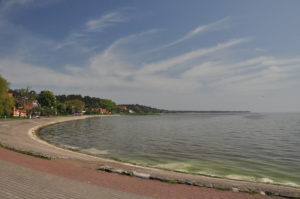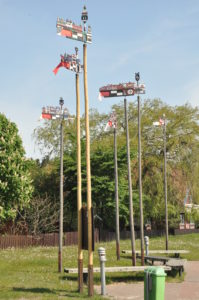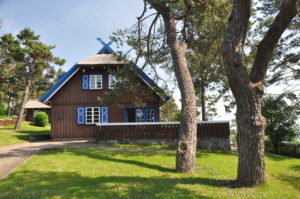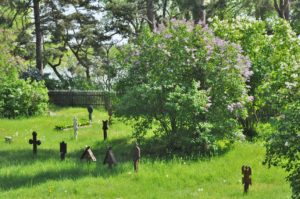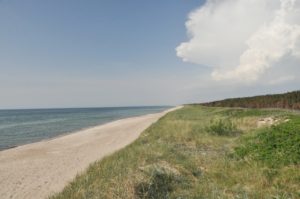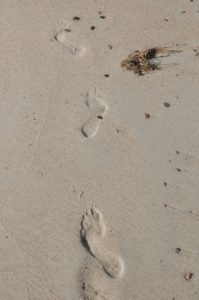Whhappp! Pthbbth! Ssssppppttthhhhtttt!
That last comes with a liberal spray of spit. I thought the bugs in spring-time New Hampshire were bad. That was nothing. It’s also obvious to me why so much amber is filled with insects.
The mosquitos way down south in Balbieriškis were large and aggressive, but they are nothing compared to the ones up here on the edge of the Baltic Sea. Last night I had to fight my way through a swarm dense enough to reduce visibility to a few feet. When we got back to the Hotel Naglis from dinner, the owner’s blonde daughter was starting a fire of birch wood in the grill, and I joined her simply for the protection afforded by the smoke. This morning the moterys, the women, were all out before seven o’clock armed with rags and brooms, sweeping window screens clean and scrubbing bug corpses from sills, clapboards and eaves.
Nida lies at the southernmost end of the Curonian Spit, a stone’s throw from Russia. It is a tourist town, full of places to buy postcards, amber and linen garments, and a magnet for bicyclists and beachgoers. The long-range forecast swore we should expect temperatures around sixty and the possibility of rain. It couldn’t be a degree less than eighty out there under a blinding sun. It is still pre-season. Restaurants are mostly empty; most guesthouses are devoid of guests.
Nonetheless there are buses wherever we go, crowds of Germans and Japanese enjoying this beautiful place, a UNESCO site since 2000 and a place so fragile that UNESCO is in constant defense against industrial activity in Kaliningrad, Russia. The lagoon between mainland Lithuania and the Spit is turgid brown and smells of dead fish—and dead fish wash up on the shore. During World War II, bombing and the movement of tanks and heavy vehicles laid waste to the pine forests and left the sandy soil at the mercy of the wind and waves. The contours of the ground, reminiscent of the land along the Western Front of World War I, recall the violence even as pines soar above mossy ground.
It is easy to see why the author and Nobel Prize winner Thomas Mann (1875-1955) fell in love with this fishing village and built a summer cottage on a high bluff overlooking the Lagoon. His architect designed a house modern in terms of early 1930s technology but close in style to the old worn homes up and down the coast. It is so easy to imagine this man, at the height of his creative powers, a literary lion in global terms, building his heart’s desire. How tragic that he had only two summers of pleasure. In 1933, with Hitler’s rise to power, Mann and his wife fled to Switzerland; in 1938 he joined the faculty of Princeton University, then moved to Los Angeles where he lived until his return to Switzerland in 1952, just a few years before his death at age 80.
I looked it up: Mann lived at 740 Amalfi Drive in Pacific Palisades before building a home at 1550 San Remo Drive. I once knew someone who lived only a few doors down on Amalfi; wish I had known then that Mann was a neighbor. Did a glimpse of the Pacific Ocean ever match what he saw from his perch in Nida?
Mann’s home is about a mile from the commercial center of town and our hotel. We passed the “Artist’s Hotel” established in the 1870s by Herman Blodė who lies alongside his wife in the Lutheran Cemetery high on the hillside across the street, Skruzdynės gatvė. A little farther along is one of the many outlets of the so-called Amber Museum. The museum is, in fact, the Gintaro Galeria Muziejūs, a shop with outlets throughout Nida and several in Vilnius. It is easily identified by its logo of interlocked “G’s.” My Dear One pointed out that the word “museum’ as applied here is similar to the “Museum of Ham”—the Museo del Jamón—in Madrid. He likes the Madrid museum better and I agree. Still we found lovely things to take home.
The heat became oppressive and we retreated for a rest in the early afternoon until it was time to go to the beach.
The wind off the Baltic Sea was cool and clean and the cold surf refreshed from the toes up. Despite the heat and humidity, few people sought out the beach. A pair of women chatted as they shook the sand from their feet and replaced their shoes; a few hundred yards south of the boardwalk that spanned the distance from road to sand there was a family—dad, mom, toddler and tiny terrier—and dad added another silver garpike to the six or eight he had already caught. The cold surf eased my swollen feet; wet sand below wrapped around my heel and arch, weight from above perfectly balanced by pressure below. Tiny shells and ocean-tumbled pebbles of rosy pinks, translucent whites, oranges, grays and dark reds asked to be collected. Some whispered, “I might be amber,” and we picked them up, seduced by dreams of discovery.
As we rolled through Juodkrantė, we watched without much hope for a place to buy žuvys, smoked fish. There she was, the old woman with a tiny booth by the side of the road. “This one,” she pointed “is very good!” Her eyes sparkled. We went with the recommendation and took also something that resembled a herring.
At home we dropped pebbles, camera and shoes at the Naglis and sauntered to the Maxima for vegetable matter and supplies for tomorrow’s journey. We found a slaw of cabbage, celery, cucumber and dill, a container of sour cream, candies, bottled water, Ekstras and an orange. In the corner between the deli counter and dairy case we ran into our sales assistant from the Amber Museum.
Sigh. It becomes home when you run into friends at the grocery store.
Oh, the žuvys recommended was fantastic: rich, tender, moist, full of the flavors of fish, fat and smoke. The slaw was the perfect side. The second shot of vodka was probably one to many.
But that’s okay. Sveikas!

